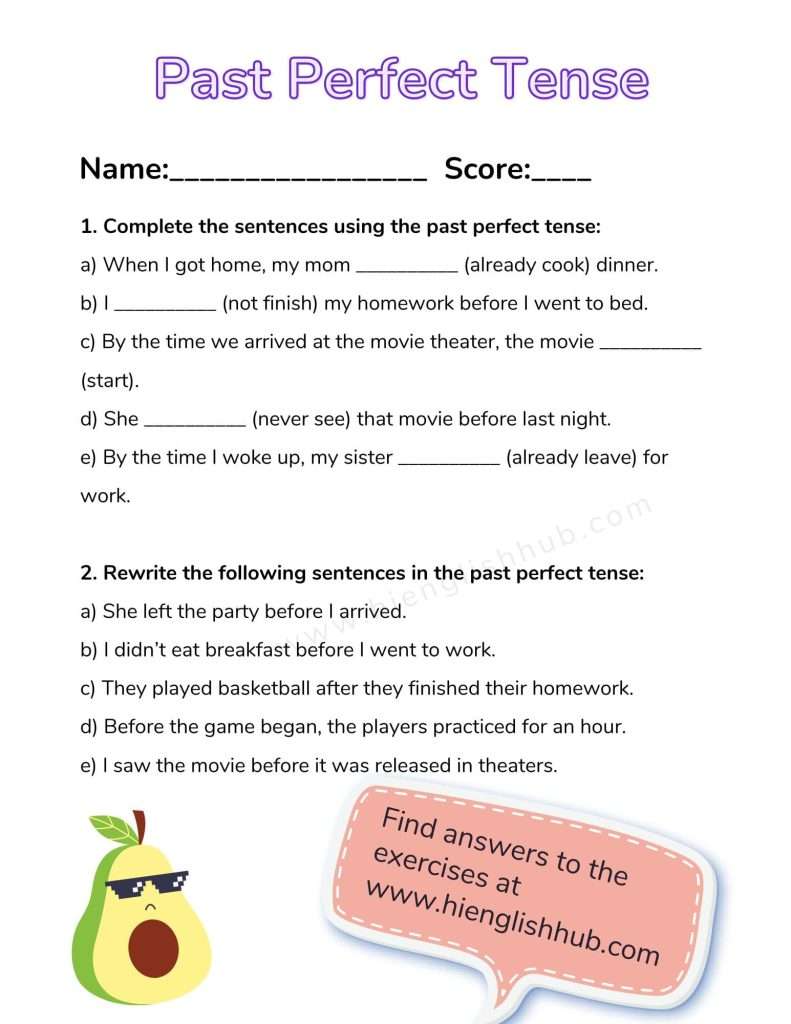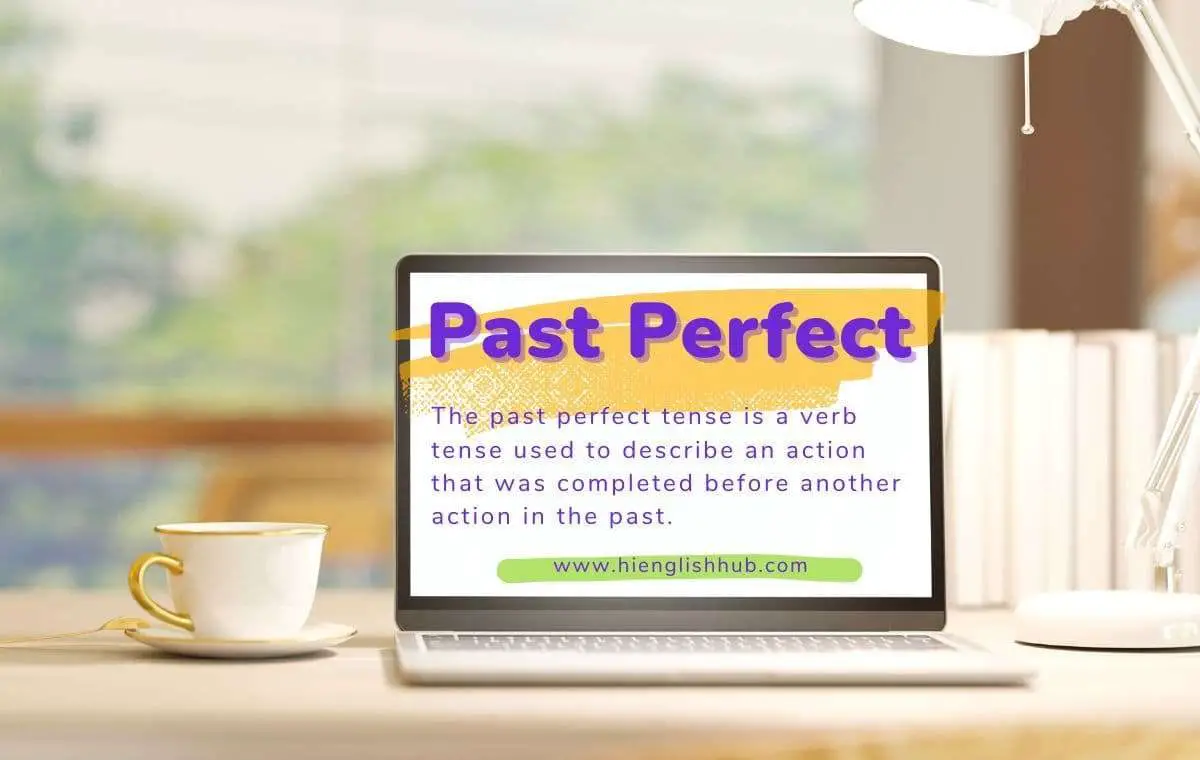Are you confused about verb tenses in English?
Don’t worry; you’re not alone!
One of the trickier tenses to master is the past perfect tense.
But fear not; I am here to help!
In this blog post, I’ll break down everything you need to know about the past perfect tense in a way that’s easy to understand.
So, let’s dive in and learn about this fascinating verb tense together!
Also read: 12 Verb Tenses In English
What Is Past Perfect Tense?
The past perfect tense is a verb tense used to describe an action that was completed before another action in the past.
For example: She had eaten breakfast before she went to work.
The Past Perfect Tense Formula
The formula for the past perfect tense is simple:
Subject + had + past participle verb
Also read: The Most Common Irregular Verbs In Past Participle
When To Use Past Perfect Tense
We use past perfect tense when we want to show the sequence of events in the past, with a focus on actions completed before another past action.
It’s commonly used in storytelling or when telling personal experiences.
It helps to create a clear and coherent narrative, making it a useful tool in storytelling and everyday conversation.
For example, “By the time I arrived at the party, everyone had already left.”
When Not To Use The Past Perfect
Alright, so we’ve talked about when to use the past perfect tense, but what about when not to use it?
Here are a few situations where the past perfect tense might not be necessary:
- When describing a series of past events without emphasizing the order in which they occurred
If you don’t need to show a clear sequence of events, the simple past tense might work just fine.
- When talking about a specific point in the past
For example, if you want to talk about what you did yesterday at 2 pm, you wouldn’t need to use the past perfect tense because there’s no other past action to compare it to.
- When the order of events is already clear from the context
In some cases, it might be obvious which past action came first, so you might not need to use the past perfect tense to show that order.
Remember, the past perfect tense is a useful tool for showing the order of past events, but it’s not always necessary.
Consider the context and the message you want to convey before deciding whether or not to use it.
Contraction With Past Perfect
Basically, contractions are just shortened versions of words or phrases.
In the case of the past perfect tense, we can use contractions to make our sentences sound more casual and conversational.
For example, “I had finished my homework” can be contracted to “I’d finished my homework.”
In the negative form, “had not” is contracted to “hadn’t.” For example, “I hadn’t seen that movie before.”
Examples Of Past Perfect Tense In Everyday Conversations
- We had already bought the tickets before the movie was sold out.
- He had reviewed grammar rules before he wrote to avoid mistakes.
- After I had played ‘Never Have I Ever,’ I realized it was a fun game.
- We had learned about the past perfect tense before we used it in our conversations.
- After I had studied a lot for the IELTS test, I got a good score.
10 Sentences Of Past Perfect Tense
- I had forgotten my phone at home before I left for work.
- He had finished his work before he went on vacation.
- They had already eaten dinner when we arrived.
- She had lost her keys before she found them in her bag.
- The store had closed by the time we got there.
- He had studied for the test for weeks.
- She had already taken a shower before we went to the beach.
- They had seen the movie before it was released in theaters.
- I had traveled to Europe before I turned 18.
- I had eaten breakfast before I went to school.
Present Perfect Vs. Past Perfect
Let’s compare two tenses that often get mixed up: the present perfect and the past perfect.
Here’s a handy table to help you understand the differences between the two:
| Tense | Form | Example | Meaning |
|---|---|---|---|
| Past Perfect | had + past participle | I had studied English for five years before I moved to the United States. | – Describes a completed action in the past that happened before another past event – Shows the sequence of events in the past |
| Past Simple | past tense of verb | I walked to the store. | Simply describes a past action with no connection to the present or to other past events. |
As you can see from the examples, the present perfect tense is used to describe something that started in the past and is still relevant in the present/ongoing in the present.
On the other hand, the past perfect tense is used to describe a completed action in the past that happened before another past action.
Easy, right?
Past Perfect Vs. Past Simple
| Tense | Form | Example | Meaning |
|---|---|---|---|
| Past Perfect | had + past participle | I had studied English for five years before I moved to the United States. | – Describes a completed action in the past that happened before another past event. – Shows the sequence of events in the past. |
| Past Simple | past tense of verb | I walked to the store. | Simply describes a past action with no connection to the present or to other past events. |
So, if you want to emphasize the order of events in the past, use the past perfect tense.
But if you just want to describe a past action without any connection to the present or other past events, use the simple past tense.
Past Perfect Tense Worksheet With Answers
Here is a worksheet with exercises to practice using the past perfect tense. Don’t forget to refer to the lessons above if you need help!

1. Complete the sentences using the past perfect tense:
a) When I got home, my mom __________ (already cook) dinner.
b) I __________ (not finish) my homework before I went to bed.
c) By the time we arrived at the movie theater, the movie __________ (start).
d) She __________ (never see) that movie before last night.
e) By the time I woke up, my sister __________ (already leave) for work.
2. Rewrite the following sentences in the past perfect tense:
a) She left the party before I arrived.
b) I didn’t eat breakfast before I went to work.
c) They played basketball after they finished their homework.
d) Before the game began, the players practiced for an hour.
e) I saw the movie before it was released in theaters.
1.
a) When I got home, my mom had already cooked dinner.
b) I had not finished my homework before I went to bed.
c) By the time we arrived at the movie theater, the movie had started.
d) She had never seen that movie before last night.
e) By the time I woke up, my sister had already left for work.
2.
a) She had left the party before I arrived.
b) I hadn’t eaten breakfast before I went to work.
c) They played basketball after they had finished their homework.
d) Before the game began, the players had practiced for an hour.
e) I had seen the movie before it was released in theaters.
Wrapping Up
Well done!
You have now learned about the past perfect tense and how to use it in your everyday conversations.
By mastering the past perfect tense, you can tell your stories more vividly and create a clearer picture of the sequence of events that occurred.
Remember, practice makes perfect, so keep practicing and using past perfect tense in your everyday conversations or writing.
If you found this guide helpful, please feel free to share it with your friends and follow Hi English Hub on Pinterest and Twitter for more language tips and guides.
Thank you for reading!

